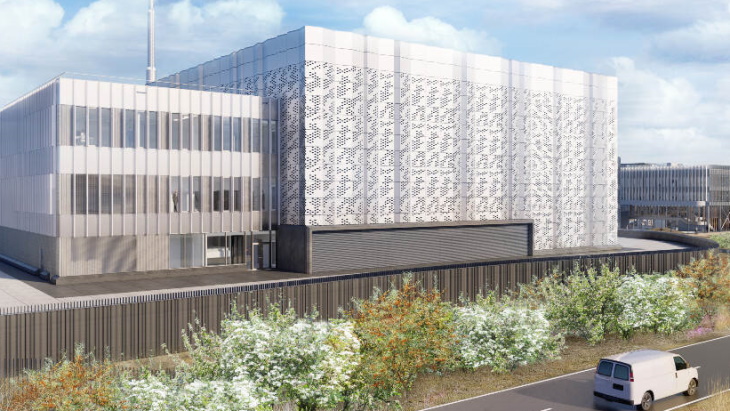The Foundation Preparation Pallas-reactor has applied to the nuclear regulator for a permit under the Nuclear Energy Act to construct and operate the Pallas research reactor in the Netherlands. It has also applied for a permit under the Water Act for the intake and discharge of cooling water for the reactor.

How the Pallas reactor could look (Image: ANVS)
The foundation - which is responsible for obtaining a licensable design, obtaining private investors and constructing and operating the Pallas reactor - submitted both application on 15 June.
It applied to the Authority for Nuclear Safety and Radiation Protection (ANVS) for the Nuclear Energy Act permit to build and operate the facility. As part of the application, an Environmental Impact Assessment (EIA) and the Safety Report were also submitted. The EIA systematically and objectively describes all the environmental consequences of the reactor and several alternatives to these, while the Safety Report describes, among other things, how the installation works: from the design and operation of the cooling pipes and ventilation systems, to how accident situations will be dealt with.
The Pallas foundation also applied to the Rijkswaterstaat (RWS) for a Water Permit. RWS is part of the Dutch Ministry of Infrastructure and Water Management and is responsible for the design, construction, management and maintenance of the main infrastructure facilities in the Netherlands.
The Water Act permit is linked to the Nuclear Energy Act and regulates the intake of cooling water from the North Holland Canal and the discharge of cooling water into the North Sea.
While ANVS coordinates the review process and communicates about both permits, RWS will assess the application for a Water Permit and ANVS will assess the application for the Nuclear Energy Act permit.
ANVS has said the application for the Nuclear Energy Act permit "contains the required information and is now being processed". It will be assessed primarily in terms of the design, the Pallas organisation, and the related nuclear safety.
ANVS said that if it assesses the permit application as satisfactory, a so-called draft permit will be issued. This is expected to take about four months. The draft permit, it said, will therefore be published for public consultation by October at the latest. The consultation period will last for six weeks.
Following the consultation period, ANVS said it will study all responses and include these in the decision whether the permit can be issued and what conditions are included to protect people and the environment. ANVS must make this decision by February 2023 at the latest.
To enable construction of the new reactor, various government agencies must make decisions and grant the required permits. The current zoning plan must therefore be revised. To this end, the foundation submitted a legally-mandated EIA for revising the zoning plan to the municipality of Schagen. This was done at the end of 2017 and the municipality approved the zoning plan in 2019.
In March this year, the Pallas foundation applied to the municipality of Schagen for the environmental permit for the construction of the Pallas reactor. The municipality will assess whether the application to build fits within the zoning plan.
At the end of 2020, the foundation submitted an application under the Nature Conservation Act to the Noord-Holland Noord environmental service. This law protects Dutch nature reserves and plant and animal species. The Nature Conservation Act Permit was issued at the beginning of 2022.
The Pallas research reactor is to be built at Petten to replace the existing High Flux Reactor (HFR). The 45 MW HFR started operating in September 1960, since when its use has largely been shifted from nuclear materials testing to fundamental research and the production of medical radioisotopes. The reactor - operated by NRG on behalf of the European Union's Joint Research Centre - has for a long time supplied about 60% of Europe's and 30% of the world's use of medical radioactive sources.
Pallas will be of the "tank-in-pool" type, with a thermal power of around 55 MW, and able to deploy its neutron flux more efficiently and effectively than the HFR. The new reactor is expected to begin operation around 2024.
The Dutch government has yet to make a final decision on constructing the Pallas reactor.
Researched and written by World Nuclear News